英汉语篇翻译
- 格式:pdf
- 大小:154.50 KB
- 文档页数:3
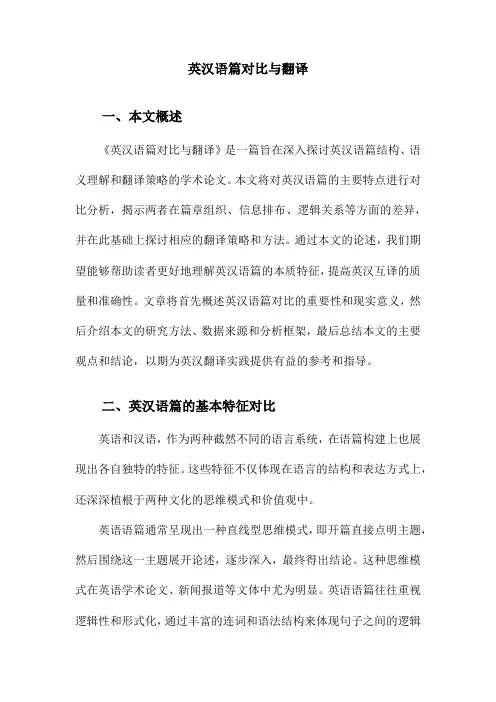
英汉语篇对比与翻译一、本文概述《英汉语篇对比与翻译》是一篇旨在深入探讨英汉语篇结构、语义理解和翻译策略的学术论文。
本文将对英汉语篇的主要特点进行对比分析,揭示两者在篇章组织、信息排布、逻辑关系等方面的差异,并在此基础上探讨相应的翻译策略和方法。
通过本文的论述,我们期望能够帮助读者更好地理解英汉语篇的本质特征,提高英汉互译的质量和准确性。
文章将首先概述英汉语篇对比的重要性和现实意义,然后介绍本文的研究方法、数据来源和分析框架,最后总结本文的主要观点和结论,以期为英汉翻译实践提供有益的参考和指导。
二、英汉语篇的基本特征对比英语和汉语,作为两种截然不同的语言系统,在语篇构建上也展现出各自独特的特征。
这些特征不仅体现在语言的结构和表达方式上,还深深植根于两种文化的思维模式和价值观中。
英语语篇通常呈现出一种直线型思维模式,即开篇直接点明主题,然后围绕这一主题展开论述,逐步深入,最终得出结论。
这种思维模式在英语学术论文、新闻报道等文体中尤为明显。
英语语篇往往重视逻辑性和形式化,通过丰富的连词和语法结构来体现句子之间的逻辑关系,使整个篇章结构紧凑、层次分明。
相比之下,汉语语篇则更多地采用螺旋型思维模式。
在汉语表达中,作者往往先从外围入手,通过描绘背景、渲染气氛等方式逐渐引出主题。
这种思维模式在汉语文学作品、日常会话中尤为常见。
同时,汉语语篇更注重意合性,即通过语境和语义的关联来实现句子之间的衔接和连贯,而非依赖明显的连词或语法结构。
造成这种差异的原因在于英汉两种文化的不同。
英语文化强调逻辑性和客观性,注重分析和推理,因此英语语篇也呈现出一种客观、直接的风格。
而汉语文化则更注重整体性和和谐性,强调综合和感悟,因此汉语语篇更倾向于采用一种委婉、含蓄的表达方式。
了解英汉语篇的这些基本特征差异,对于提高英汉互译的质量具有重要意义。
在翻译过程中,译者需要充分考虑到两种语言在语篇构建上的不同特点,灵活运用各种翻译技巧和方法,以实现原文与译文在语义、风格和文化内涵上的对等。
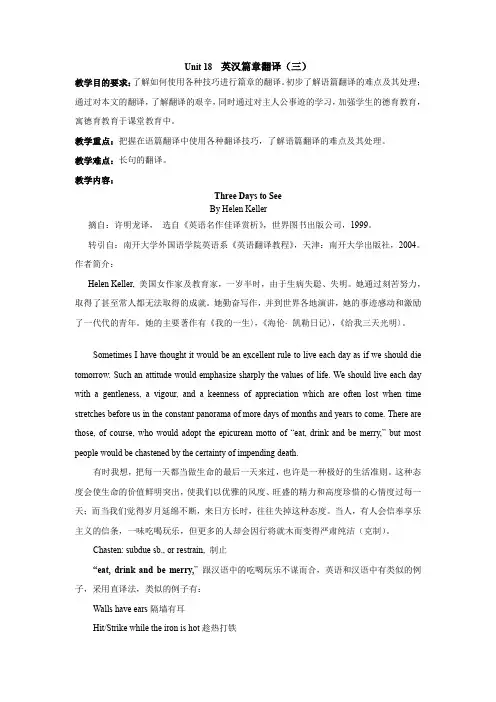
Unit 18 英汉篇章翻译(三)教学目的要求:了解如何使用各种技巧进行篇章的翻译。
初步了解语篇翻译的难点及其处理;通过对本文的翻译,了解翻译的艰辛,同时通过对主人公事迹的学习,加强学生的德育教育,寓德育教育于课堂教育中。
教学重点:把握在语篇翻译中使用各种翻译技巧,了解语篇翻译的难点及其处理。
教学难点:长句的翻译。
教学内容:Three Days to SeeBy Helen Keller摘自:许明龙译,选自《英语名作佳译赏析》,世界图书出版公司,1999。
转引自:南开大学外国语学院英语系《英语翻译教程》,天津:南开大学出版社,2004。
作者简介:Helen Keller, 美国女作家及教育家,一岁半时,由于生病失聪、失明。
她通过刻苦努力,取得了甚至常人都无法取得的成就。
她勤奋写作,并到世界各地演讲,她的事迹感动和激励了一代代的青年。
她的主要著作有《我的一生〉,《海伦·凯勒日记〉,《给我三天光明〉。
Sometimes I have thought it would be an excellent rule to live each day as if we should die tomorrow. Such an attitude would emphasize sharply the values of life. We should live each day with a gentleness, a vigour, and a keenness of appreciation which are often lost when time stretches before us in the constant panorama of more days of months and years to come. There are those, of course, who would adopt the epicurean motto of “eat, drink and be merry,” but most people would be chastened by the certainty of impending death.有时我想,把每一天都当做生命的最后一天来过,也许是一种极好的生活准则。
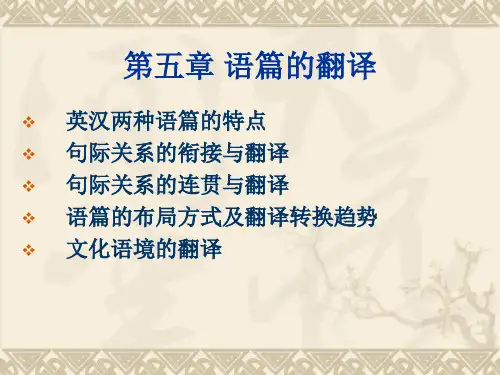
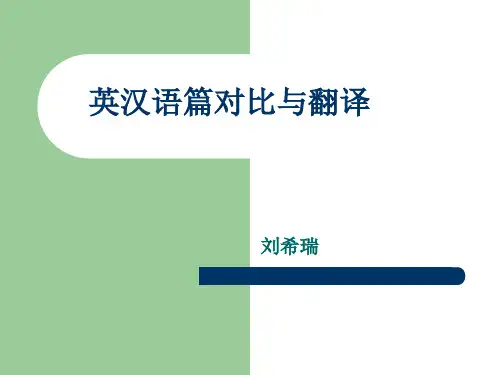
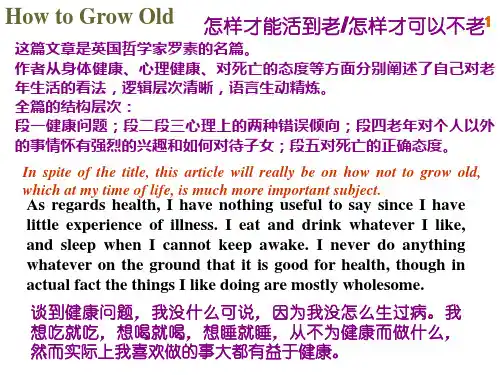
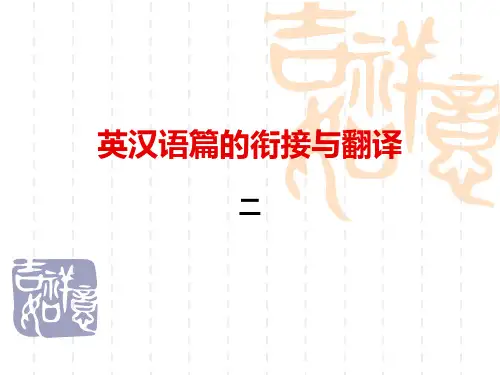
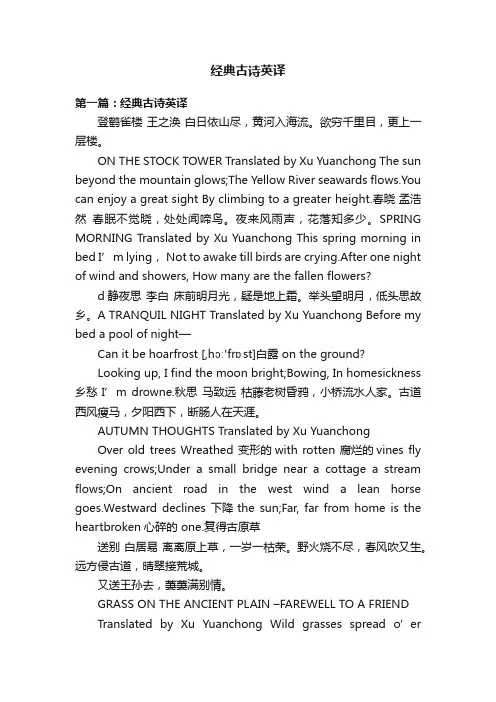
经典古诗英译第一篇:经典古诗英译登鹳雀楼王之涣白日依山尽,黄河入海流。
欲穷千里目,更上一层楼。
ON THE STOCK TOWER Translated by Xu Yuanchong The sun beyond the mountain glows;The Yellow River seawards flows.You can enjoy a great sight By climbing to a greater height.春晓孟浩然春眠不觉晓,处处闻啼鸟。
夜来风雨声,花落知多少。
SPRING MORNING Translated by Xu Yuanchong This spring morning in bed I’m lying, Not to awake till birds are crying.After one night of wind and showers, How many are the fallen flowers?d静夜思李白床前明月光,疑是地上霜。
举头望明月,低头思故乡。
A TRANQUIL NIGHT Translated by Xu Yuanchong Before my bed a pool of night—Can it be hoarfrost [,hɔː'frɒst]白露 on the ground?Looking up, I find the moon bright;Bowing, In homesickness 乡愁I’m drowne.秋思马致远枯藤老树昏鸦,小桥流水人家。
古道西风瘦马,夕阳西下,断肠人在天涯。
AUTUMN THOUGHTS Translated by Xu YuanchongOver old trees Wreathed 变形的with rotten 腐烂的vines fly evening crows;Under a small bridge near a cottage a stream flows;On ancient road in the west wind a lean horse goes.Westward declines 下降the sun;Far, far from home is the heartbroken心碎的 one.复得古原草送别白居易离离原上草,一岁一枯荣。
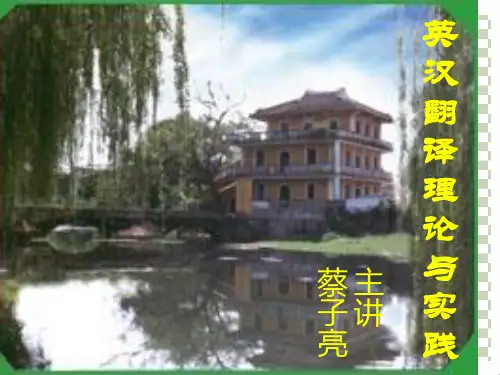
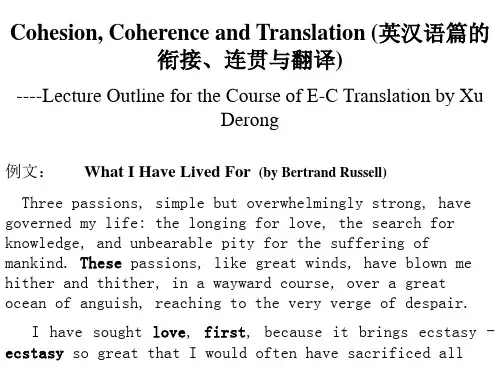
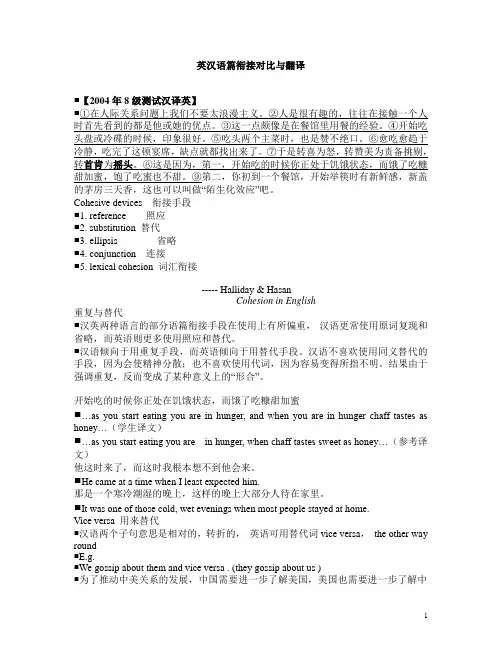
英汉语篇衔接对比与翻译【2004年8级测试汉译英】①在人际关系问题上我们不要太浪漫主义。
②人是很有趣的,往往在接触一个人时首先看到的都是他或她的优点。
③这一点颇像是在餐馆里用餐的经验。
④开始吃头盘或冷碟的时候,印象很好。
⑤吃头两个主菜时,也是赞不绝口。
⑥愈吃愈趋于冷静,吃完了这顿宴席,缺点就都找出来了。
⑦于是转喜为怒,转赞美为责备挑剔,转首肯为摇头。
⑧这是因为,第一,开始吃的时候你正处于饥饿状态,而饿了吃糠甜加蜜,饱了吃蜜也不甜。
⑨第二,你初到一个餐馆,开始举筷时有新鲜感,新盖的茅房三天香,这也可以叫做“陌生化效应”吧。
Cohesive devices 衔接手段1. reference 照应2. substitution 替代3. ellipsis 省略4. conjunction 连接5. lexical cohesion 词汇衔接----- Halliday & HasanCohesion in English重复与替代汉英两种语言的部分语篇衔接手段在使用上有所偏重,汉语更常使用原词复现和省略,而英语则更多使用照应和替代。
汉语倾向于用重复手段,而英语倾向于用替代手段。
汉语不喜欢使用同义替代的手段,因为会使精神分散;也不喜欢使用代词,因为容易变得所指不明。
结果由于强调重复,反而变成了某种意义上的“形合”。
开始吃的时候你正处在饥饿状态,而饿了吃糠甜加蜜…as you start eating you are in hunger, and when you are in hunger chaff tastes as honey…(学生译文)…as you start eating you are in hunger, when chaff tastes sweet as honey…(参考译文)他这时来了,而这时我根本想不到他会来。
He came at a time when I least expected him.那是一个寒冷潮湿的晚上,这样的晚上大部分人待在家里。
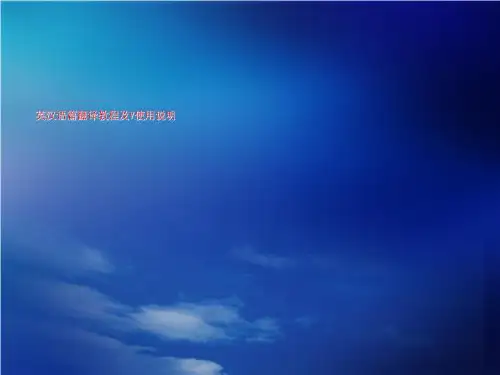
英语专八考试英译汉语篇翻译专八考试关于英译汉中,语篇(discourse或text)是一系列句子构成的语言整体。
它合乎语法、语义连贯,具有一定的逻辑结构。
在翻译时,应当把它作为一个语义整体来考虑。
从这个意义上讲,前述的译词技巧和译句技巧都要以语篇为落脚点。
对篇章的理解不能断章取义,只见树木,不见森林,应采用从宏观到微观、自上而下(top-down approach)的翻译方法,即先弄清文章主题,再对词句进行微观分析,篇中求句,句中求字。
1.语篇衔接衔接体现在语篇的表层结构上,通常是通过语法和词汇手段将语句聚合在一起,形成语篇的有形网络。
英语常用连接词(如连词、关系代词、关系副词)、指称语(如人称代词及相应的物主代词)、特有的冠词实现衔接,而汉语常用省略(如主语和连接词)和重复的手法。
英译汉时,英语的代词、关系代词等语法衔接手段常还原为名词,以词汇衔接的形式表现出来。
这一点我们在谈到“增词”技巧时已经谈及。
例1原文:At any given moment the traveler could find examples in both of the same architecture, the same style in dress, the same books on the shelves.译文:旅行者在美国和欧洲随时都可以看到类似的东西,诸如风格相同的建筑物,款式相似的服饰,书架上也摆着相同的书籍。
例2原文:,The question is: why should we?译文:但问题在于我们为什么要这么做?2.语篇连贯连贯(coherence)指的是语篇中不同成分之间的语义关联。
语义的逻辑关系经常隐藏在字里行间,在英语里连贯的语篇模式在汉语中可能就有欠连贯,需要借助一些词汇性的连贯标记、信息的合理排列来实现译文语篇的连贯。
例原文:He finds that students who were easy to teach, because they succeeded in putting what they had been taught into practice,hesitate when confronted with the vast untouched area of English vocabulary and usage which falls outside the scope of basic text books.译文:学生们最初很容易教,因为他们能把教他们的东西付诸实践,现在教师却发现他们面对着大量未曾接触过的英语词汇和惯用法而踌躇起来,因为这些词汇和惯用法都是基础教科书所没有涉及的内容。
翻译活动所处理的不是一个个孤立的词句,而是由互相关联和制约的词语和句子,为一定的交际目的,按一定格式,有机地组合在一起的语篇.一、只有在语篇的层次上进行翻译才能把握主题例1:Deserts are very dry regions. they have very little rainfall. Few plants live there. Some specialized animals do. Some deserts have a surface of land. The sand often forms dunes. Those are created by the wind. Others have stone or rocks.译:沙漠是十分干旱的地区。
那里降雨量很少,植物也很稀少,只生存着一些特殊的动物.有些沙漠的表面是沙,沙常常被风刮成沙丘.另一些沙漠的表面则是石头或岩石.原文的主题是deserts,语篇中的they, there, others都代表着这一主题,译者要注意将主题贯穿译文成为篇章中连接各句的纽带.例2:∮一边走着,似乎道旁有一个孩子,抱着一堆灿白的东西,驴儿过去了,∮无意回头一看---他抱着花儿赤着脚儿向着我笑.——冰心,:《笑》(《中国翻译》1995年第2期)译:As I passed along, I somewhat sensed the presence of a child by the roadside carrying something snow white in his arms. After the donkey had gone by , I happened to look back and saw the child , who was barefoot , looking at me smilingly with a bunch of flowers in his arms.(张培基译)由于中国人常采取整体思维方式,强调篇章整体意义,只要主题明确主语有无关系不大,上例中符号∮代表常规省略的主语,虽然缺了两个主语,句子的整体意义仍然十分明确,翻译若不从语篇的层次去考虑的话就会出现主题模糊的现象.二、只有在语篇的层次上进行翻译,才能准确把握词语的涵义英语中有许多词有一个以上的涵义,称多义词。
Poor Birds
可怜的小鸟
There was a flock of birds in the jungle near a village. They lived together in a big tree and had a lot of fun every day. This flock of birds usually flew to different places in groups, making a beautiful picture in the sky. Sometimes they have a heated discussion in the tree.
在一个小村庄附近的丛林里有一群小鸟,它们共同栖息在一棵大树上,每天过着快乐的生活。
这群小鸟常常成群结队地飞往不同的地方,它们的身姿形成天空一道漂亮的风景。
有时,它们会在大树上展开激烈的争论
One day, a farmer went to the jungle to trap some animals for dinner. He saw a lot of birds in the tree, so he threw some corn on the ground and waited until the birds came down to eat. Then he threw a big net over the birds to trap them.
一天,一个农夫到丛林里捕捉猎物用作晚餐。
他看到大树上有很多小鸟,于是就在地上撒了些谷物,等着小鸟来吃。
然后他支起一张大网捕捉来觅食的小鸟。
When the birds were in the net, they were all afraid and wanted to get out of the net. Some birds in this net said, “Let’s help one other to fly together and push this net up into the tree so we can get out of here.”Everyone listened and count ed, “One, two, three—everyone flies!” They all flew and pushed the net up into the tree and flew out of the net.
被网罩住后,小鸟们都很害怕,想从中逃出去。
有些鸟说:“我们
大家一起飞,合力把这张网挂到树上,然后我们就能出去了。
大家都听从了这一建议,然后开始数数,‘1,2,3——飞!’所有的小鸟都飞了起来,把网挂到了树上,然后大家都从网中飞了出去。
After that, they sat in the tree and talked to each other. A black bird said,“Do you know why we did not get killed? Because of my idea! If you hadn't had me, you all would have died!! See how smart I was!!” A white bird said,“No! No! That was my idea, not yours!” Another said, “It wasn't either of your ideas; it was mine only.” Another one said, “OK! OK! If you think you are very clever and have a lot of power, next time you do it. I will not do anything. We will see how clever you are!” All the birds were quarrel ing. Everyone became upset, confused, and angry. They refused to admit other birds’ power to succeed in escaping from the net.
事后,这些小鸟停在树上讨论这件事。
一只黑色的鸟说:“你知道我们为什么得以逃脱吗?因为我出的主意,要不是我,你们大家都得丧命。
看我多聪明啊!”一只白色的鸟说:“不对,不对,那是我的主意,不是你的!”另一只说“不是你们两个任何人的主意,完全是我的主意。
”又有一只鸟说:“好吧,好吧,如果你们很聪明,很有能力,下一次你们来,我什么都不做。
看一下你们到底有多聪明!”所有的小鸟都吵个不停。
大家都变得开始烦躁,不解,气愤,都拒不承认在这件事上其它小鸟所起的作用。
A couple of days later, the farmer came to trap some birds again. This time he did the same thing as he had done before. To his surprise, there were still many birds in his net this time, too. Two or three of the birds shouted,“Hurry up! We must get out of this net. Everyone flies together.” But no one paid attention. They just wanted to do everything for themselves. A black bird said to the white bird, “You said that you had lots of power and good ideas. Now you should do something! Help everybody here. I can’t do anything because I am not smarter than you!!!” he ridiculed. Another said,“You said that you were very clever. Now show your intelligence to everyone”
过了一些日子,农夫又来捕鸟了。
这次他和之前的做法一样。
让他感到吃惊的是,他这次仍然用网捕到很多鸟。
其中有两三只鸟大喊
道:“快点,我们必须从网中逃出去。
大家一起飞。
”但是没有鸟儿听。
它们只想着自我行事。
黑鸟对白鸟说:“你说过你很有能力和想法,现在该你显身手了,帮帮大家啊,我什么也做不了,因为我没有你聪明!”它语气里带着嘲讽。
另一只鸟说,“你们说你们很聪明,那现在展示给大家看啊。
”
No one did anything. They just waited to see who would act. Finally, the farmer came to get the birds in the net. The flock didn't have time and chance to escape any more. They all became a delicious food in the farmer's family table.
没有一只鸟行动,它们只是在那儿等着看谁会行动。
最后,农夫来收网了。
小鸟们再也没有时间和机会逃跑了。
它们都成了农夫餐桌上的美食。
(478 words)。